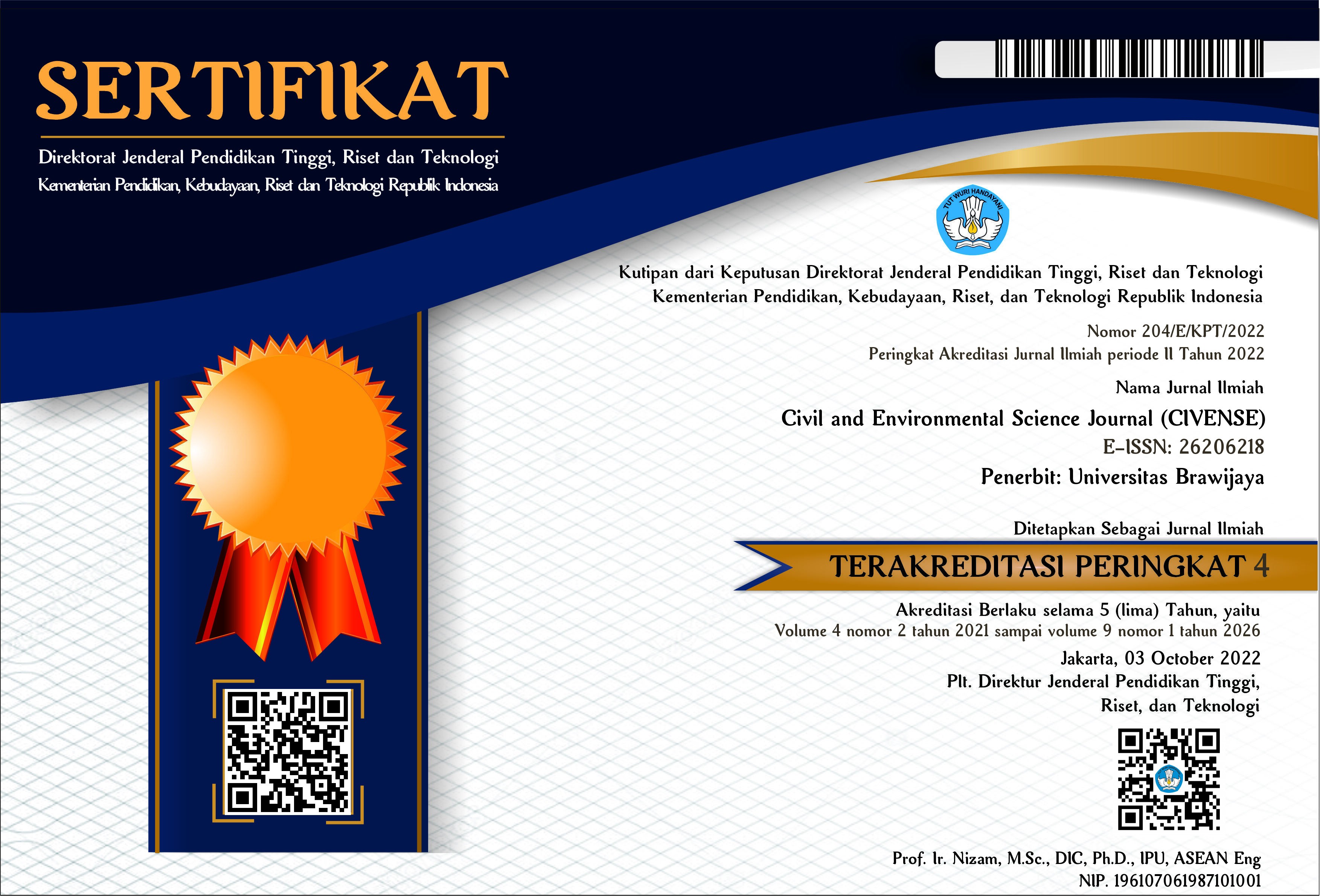Evaluation of accessibility commuter-line station with jitney transportation modes by using GIS application: a case study of Depok Station
DOI:
https://doi.org/10.21776/ub.civense.2023.00601.6Keywords:
Integration, Public Transportation, GIS, QGIS, Accessibility, Service Area, Jitney, Commuter-lineAbstract
This research aims to evaluate the aspects that can increase the Station's service area by maximising the integrated Jitney as the other public transportation modes that can increase reachability for the people near the Station. Evaluating the accessibility of some stations in the Depok area is needed to identify the infrastructure upgrading priorities, such as providing pedestrian roads and giving better access to the Station to increase the Station's service area. The methodology used in this research is analysing method using a GIS application to assess and discover the pattern of travel behaviour for public transport in the Depok municipality area. The GIS Database Design in this research uses the Spatial Database and Attribute Database, which are integrated with the QGIS application to become Maps for the service area of public transportation in the Depok Municipality. The road network in Depok municipality is dominated by the jitney route as intracity public transportation, which travels on the arterial and collector road. Then the railway is located in the central area of Depok that stretches from South to North. There are some areas that do not have access to jitney services due to this residential area being far from the arterial and collector road travelled by Jitney. Looking at its planning for jitneys in the Depok area, the availability of jitneys follows the demand of the passenger population, and there are no travel analyses from the Transportation Department of Depok Municipality or local public transport organisations (ORGANDA) as private jitney operators. The ineffective jitney route planning is the other reason that there are some uncovered residential areas from public transport access. Subsequently, there are different travel time characteristics among four commuter line stations in the Depok Municipality area. The Citayam and New Depok Stations have wider access for pedestrians which these two stations have a more extensive service area than Old Depok Station, whereas Old Depok Station has restricted access to the west area of this Station. The rearrangement of the Station access is needed, especially for Old Depok Station, by adding road access on the west side to increase the service area of the Station.
References
Ananda, N. D., Laswati, H., Rejeki, P. S., & Suyoko, A. (2022). Normal Walking Speed According to Age and Gender in Preliminary Students in Surabaya. Surabaya Physical Medicine and Rehabilitation Journal, 4(1), 15. https://doi.org/10.20473/spmrj.v4i1.24186
Aslan, H., & Kocaman, H. (2018). GIS based bus stop optimisation for sakarya public transportation system. Sakarya University Journal of Science, December 2019, 1–1. https://doi.org/10.16984/saufenbilder.394911
Azad, D. (2015). GIS Based Urban Transportation system Allahabad City. 1(July), 8. https://www.researchgate.net/publication/279900541_Thesis_GIS_based_urban_transportation_system/citation/download
Baumgartner, D. S., & Schofer, J. L. (2011). Forecasting call-n-ride productivity in low-density areas. https://trid.trb.org/view/1091388
Calastri, C., Hess, S., Choudhury, C., Daly, A., & Gabrielli, L. (2019). Mode choice with latent availability and consideration: Theory and a case study. Transportation Research Part B: Methodological, 123, 374–385. https://www.sciencedirect.com/science/article/abs/pii/S0191261517305428?via%3Dihub
Jou, R. C., & Chen, T. Y. (2014). Factors affecting public transportation, car, and motorcycle usage. Transportation Research Part A: Policy and Practice, 61(2014), 186–198. https://doi.org/10.1016/j.tra.2014.02.011
Kwan, M. P., & Weber, J. (2008). Scale and accessibility: Implications for the analysis of land use-travel interaction. Applied Geography, 28(2), 110–123. https://doi.org/10.1016/j.apgeog.2007.07.002
Lei, Xinyue; Guo, Xiucheng; Liu, Shanshan; Chen, Hao; Zou, Y. (2019). Analysis of transit accessibility to transportation hubs at multi-scale based on open data and arcGIS: the case of Nanjing. 1810–1822. https://ascelibrary.org/doi/pdf/10.1061/9780784482292.384
Newman, P., & Kenworthy, J. (1999). Sustainability and cities: overcoming automobile dependence. Island press. https://books.google.co.id/books?hl=id&lr=&id=pjatbiavDZYC&oi=fnd&pg=PR13&dq=Newman,+P.,+%26+Kenworthy,+J.&ots=BcKYoItBzB&sig=6Z37n9iUVYCNG-M_lsRzC_j4JFA&redir_esc=y#v=onepage&q=Newman%2C P.%2C %26 Kenworthy%2C J.&f=false
Poelman, H., & Dijkstra, L. (2020). Rail transport performance in europe : Developing a new set of regional and territorial accessibility indicators for rail. https://ec.europa.eu/regional_policy/sources/docgener/work/032020_rail_transport_performance.pdf
Quinta, F. A., & Prakoso, H. B. S. E. (2016). Kajian Pemanfaatan Moda Transportasi Kereta Rel Listrik (KRL) Commuter Line Dalam Pergerakan Komuter Bekasi-Jakarta. Universitas Gadjah Mada, 1–10.
Sitorus, B. (2019). Kajian Pembenahan Angkutan Masal Untuk Mengurangi Kemacetan Lalu Lintas di DKI Jakarta. Warta Penelitian Perhubungan, 25(3), 177. https://doi.org/10.25104/warlit.v25i3.719
Sudrajat, A. (2019). Faktor Penyebab dan Upaya Mengatasi Kemacetan di DKI Jakarta. Academia. https://www.academia.edu/43404753/Faktor_Penyebab_dan_Upaya_Mengatasi_Kemacetan_di_DKI_Jakarta
Sung, H., Choi, K., Lee, S., & Cheon, S. H. (2014). Exploring the impacts of land use by service coverage and station-level accessibility on rail transit ridership. Journal of Transport Geography, 36, 134–140. https://doi.org/10.1016/j.jtrangeo.2014.03.013
Walker, J. (2012). Human Transit. Island Press. https://humantransit.org/book
Yong, Y., & Diez-Roux, A. V. (2013). Walking Distance by Trip Purpose and Population Subgroups Yong. Am J Prev Med, 43(1), 11–19. https://doi.org/10.1016/j.amepre.2012.03.015.Walking
Yosritzal, Kemal, B. M., Purnawan, & Putra, H. (2018). An observation of the walking speed of evacuees during a simulated tsunami evacuation in Padang, Indonesia. IOP Conference Series: Earth and Environmental Science, 140(1). https://doi.org/10.1088/1755-1315/140/1/012090
Downloads
Published
How to Cite
Issue
Section
License
Copyright (c) 2023 Bayu Alif Hardiyansyah, Fauzul Rizal Sutikno, Michelle Zeibots, Kasun De Silva Wijayaratna

This work is licensed under a Creative Commons Attribution-NonCommercial 4.0 International License.
Authors who publish with this journal agree to the following terms:
Authors retain copyright and grant the journal right of first publication with the work simultaneously licensed under a Attribution-NonCommercial 4.0 International License that allows others to share the work with an acknowledgement of the work's authorship and initial publication in this journal.
Authors are able to enter into separate, additional contractual arrangements for the non-exclusive distribution of the journal's published version of the work (e.g., post it to an institutional repository or publish it in a book), with an acknowledgement of its initial publication in this journal.
Authors are permitted and encouraged to post their work online (e.g., in institutional repositories or on their website) prior to and during the submission process, as it can lead to productive exchanges, as well as earlier and greater citation of published work (See the Effect of Open Access).














